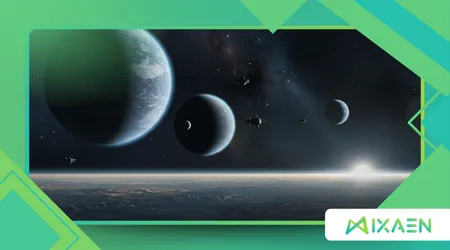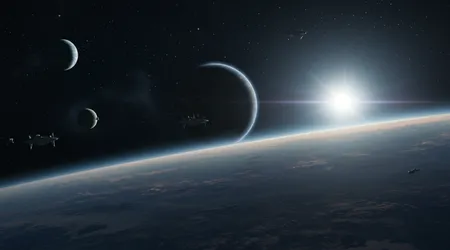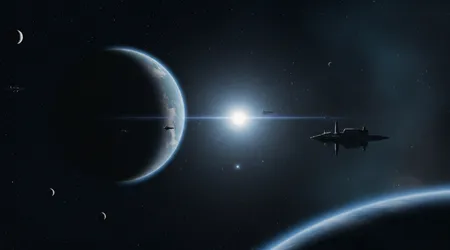The TRAPPIST-1 System: A Real-Life Sci-Fi Neighborhood

The TRAPPIST-1 System captivates astronomers and dreamers alike, a cosmic neighborhood just 40 light-years away that feels ripped from science fiction.
Anúncios
Discovered in 2017, this compact star system hosts seven Earth-sized planets orbiting a dim, ultracool red dwarf star.
Its discovery sparked global fascination, not just for its proximity but for its potential to harbor life. Imagine a stellar backyard where planets huddle closer to their star than Mercury does to our Sun, yet some may hold liquid water.
This article dives into why The TRAPPIST-1 System is a scientific marvel, exploring its unique traits, habitability prospects, and what it teaches us about life beyond Earth.
Why does this distant system feel like a galactic story we’re only beginning to read? Let’s unpack its mysteries with fresh eyes.
This system’s allure lies in its delicate balance of extremes planets packed tightly around a star just 8% of our Sun’s mass.
Unlike our sprawling Solar System, The TRAPPIST-1 System is a masterclass in cosmic efficiency, with orbits so close they’d fit inside Mercury’s path.
Yet, its faint star creates habitable zones where life might thrive. Recent studies, like those from the James Webb Space Telescope (JWST), have deepened our understanding, revealing clues about atmospheres and surface conditions.
As we probe this system, we’re not just chasing aliens but redefining what makes a planet livable. Join me as we explore its planets, their potential, and the questions they raise about our place in the universe.
A Star Unlike Our Own
At the heart of The TRAPPIST-1 System sits an ultracool red dwarf, a star so faint it’s invisible to the naked eye. Red dwarfs dominate the galaxy, making up 70% of its stars, yet TRAPPIST-1 stands out for its compact size and cool temperature.
Barely larger than Jupiter, it burns at a mere 2,550 Kelvin, compared to our Sun’s 5,500 Kelvin. This creates a habitable zone startlingly close to the star, where planets can maintain liquid water despite tight orbits.
Picture a campfire: you need to sit close to feel its warmth, and TRAPPIST-1’s planets do just that.
This star’s faint glow shapes the system’s unique dynamics. Its low energy output means planets must orbit within 0.06 astronomical units (AU) to be habitable, compared to Earth’s 1 AU from the Sun.
Such proximity causes tidal locking, where one side of each planet always faces the star, creating eternal day and night zones.
++ Life on Super-Earths: Could We Survive There?
This could lead to extreme climates, with scorching daysides and frozen nightsides, challenging life as we know it. Yet, the star’s longevity potentially trillions of years gives any lifeforms ample time to evolve.
Recent JWST observations have spotlighted TRAPPIST-1’s activity. Flares from the star could strip planetary atmospheres, yet some planets may retain them, hinting at resilience.
These findings, published in Nature Astronomy in 2024, suggest complex atmospheric dynamics.
The star’s quirks force us to rethink habitability, as its faint light and violent outbursts create a cosmic tightrope for life. Understanding this star is key to decoding the system’s potential for hosting biology.

Seven Planets, Seven Stories
The TRAPPIST-1 System boasts seven rocky planets, each a unique world with its own tale. Labeled b through h, they range from 0.33 to 1.38 Earth masses, all roughly Earth-sized.
Their orbits are astonishingly tight, completing in days rather than months, with the farthest planet, h, orbiting in just 18.8 days.
This compactness creates a gravitational dance, where planets tug on each other, stabilizing their orbits through resonance. It’s like a cosmic orchestra, each planet playing a note in harmony.
Consider TRAPPIST-1e, often hailed as the system’s Goldilocks. Orbiting at 0.029 AU, it receives just the right stellar energy for liquid water.
Also read: The Goldilocks Zone: Why It’s Not the Only Place Life Could Exist
JWST data from 2024 suggests it may have a thin atmosphere, possibly rich in carbon dioxide, hinting at habitability.
Contrast this with TRAPPIST-1b, the closest planet, which is likely too hot, with surface temperatures exceeding 400 Kelvin.
Yet, even b intrigues scientists, as JWST detected possible atmospheric signatures, per a 2023 Astrophysical Journal study.
Further out, TRAPPIST-1g and f also lie in the habitable zone, but their stories differ. Planet g’s thicker atmosphere might trap heat, while f could be a water-rich world.
These variations spark questions: Could microbial life cling to g’s surface? Might f host oceans? Each planet’s unique conditions make The TRAPPIST-1 System a laboratory for studying planetary diversity and evolution.
Read more: How Astronomers Detect Planets They Can’t Even See
Habitability: A Cosmic Gamble
The quest for life in The TRAPPIST-1 System hinges on habitability, a delicate balance of temperature, atmosphere, and stability. Planets e, f, and g sit in the habitable zone, where liquid water could exist.
A 2024 study in Nature Astronomy estimated a 60% chance that at least one of these planets retains water, based on atmospheric retention models. But habitability isn’t just about water it’s about surviving the star’s flares and tidal locking’s extremes.
Tidal locking creates stark contrasts: one side bakes under constant starlight, the other freezes in perpetual darkness. Life might thrive in the twilight zones, where temperatures are moderate.
Imagine alien microbes clustering in these narrow bands, like desert plants hugging an oasis. However, stellar flares pose a threat, potentially stripping atmospheres.
JWST’s 2024 data on TRAPPIST-1c showed no significant atmosphere, suggesting vulnerability, yet e’s potential atmosphere offers hope.
Could life adapt to such extremes? Earth’s extremophiles microbes thriving in scalding vents or Antarctic ice suggest it’s possible.
The TRAPPIST-1 System challenges our assumptions, pushing us to imagine life beyond Earth’s blueprint.
If life exists here, it might be unlike anything we know, thriving in conditions we’d call hostile. This gamble keeps scientists glued to their telescopes, seeking biosignatures.
The Role of JWST in Unraveling Mysteries
The James Webb Space Telescope has revolutionized our view of The TRAPPIST-1 System. Launched in 2021, JWST’s infrared capabilities pierce the system’s secrets, analyzing planetary atmospheres with unprecedented detail.
In 2023, it detected possible water vapor on TRAPPIST-1b, a planet thought too hot for habitability, sparking debate about atmospheric retention. This data, reported in Science, underscores JWST’s power to challenge assumptions.
JWST’s observations focus on spectroscopy, analyzing starlight filtered through planetary atmospheres to identify gases like methane or oxygen.
For TRAPPIST-1e, 2024 data hinted at a carbon-rich atmosphere, a potential biosignature. These findings aren’t conclusive but narrow the gap between speculation and evidence.
The telescope’s precision lets us probe worlds 40 light-years away, turning sci-fi into science.
Beyond atmospheres, JWST explores surface conditions. Its 2024 study of TRAPPIST-1c suggested a rocky, barren world, yet subtle thermal emissions hinted at geological activity.
This paints The TRAPPIST-1 System as dynamic, with planets possibly reshaped by internal forces. JWST’s ongoing mission promises more revelations, bringing us closer to answering whether life exists beyond Earth.
A Laboratory for Planetary Evolution
The TRAPPIST-1 System serves as a cosmic laboratory, offering insights into how planets form and evolve. Its seven worlds, born from the same protoplanetary disk, vary widely in density and composition.
A 2024 Nature Astronomy paper proposed a two-step formation model, where planets formed closer to the star before migrating outward. This explains their tight orbits and diverse traits.
The system’s resonance planets’ orbits syncing in precise ratios reveals clues about stability. For example, TRAPPIST-1d completes three orbits for every two of e’s, a 3:2 resonance.
This gravitational harmony, detailed in the table below, prevents collisions and suggests a long-lived system. Such stability is crucial for life, allowing ecosystems to develop over billions of years.
| Planet | Orbital Period (Days) | Resonance Ratio |
|---|---|---|
| TRAPPIST-1b | 1.51 | – |
| TRAPPIST-1c | 2.42 | 5:3 with b |
| TRAPPIST-1d | 4.05 | 3:2 with c |
| TRAPPIST-1e | 6.10 | 3:2 with d |
| TRAPPIST-1f | 9.21 | 3:2 with e |
| TRAPPIST-1g | 12.35 | 4:3 with f |
| TRAPPIST-1h | 18.77 | 3:2 with g |
This resonance, akin to a cosmic clock, highlights the system’s complexity. Studying it helps us understand how planets elsewhere might form, offering a blueprint for exoplanet research.
The system’s diversity hot b, temperate e, icy h mirrors potential evolutionary paths, making it a treasure trove for science.
The tight orbits also suggest intense geological activity. Tidal forces, like those sculpting Jupiter’s moon Io, could drive volcanism on planets like d or e.
Such activity might sustain atmospheres or release gases conducive to life. By studying The TRAPPIST-1 System, we glimpse how planetary systems age, adapt, and perhaps nurture life over eons.
What It Means for the Search for Life

The search for life in The TRAPPIST-1 System isn’t just about finding aliens it’s about redefining life’s possibilities. Planets e, f, and g, with their potential for water, challenge Earth-centric views.
A 2024 study estimated a 60% chance of water on at least one planet, fueling optimism. But life here might not resemble Earth’s, thriving in twilight zones or subsurface oceans.
Consider a sci-fi scenario: on TRAPPIST-1f, subsurface microbes feed on geothermal energy, like Earth’s deep-sea vent organisms.
Or picture TRAPPIST-1e, where a thin atmosphere supports lichen-like life in dim starlight. These examples, grounded in Earth analogs, show how life might adapt.
The system’s diversity pushes us to broaden our search for biosignatures, from methane to exotic gases.
The system also raises philosophical questions. If life exists here, what does it mean for humanity’s place in the cosmos? Finding even microbial life would rewrite our story, suggesting life is common.
The TRAPPIST-1 System isn’t just a destination it’s a mirror reflecting our curiosity and hope for connection in the universe.
Conclusion: A Cosmic Story Unfolding
The TRAPPIST-1 System is more than a collection of planets it’s a narrative of possibility, etched in starlight 40 light-years away.
Its seven worlds, orbiting a faint red dwarf, challenge our understanding of habitability and planetary evolution.
From JWST’s revelations to the system’s resonant orbits, every discovery pulls us closer to answering whether we’re alone.
This cosmic neighborhood, with its tight-knit planets and potential for life, feels like a sci-fi saga unfolding in real time.
As we peer deeper, The TRAPPIST-1 System invites us to dream, question, and explore what lies beyond our pale blue dot.
Each planet tells a story, from scorching b to temperate e, offering clues about life’s tenacity. The system’s resonance and diversity make it a scientific goldmine, while JWST’s data keeps us on the edge of our seats.
Will we find biosignatures or barren rocks? The answer lies in continued exploration, fueled by curiosity and technology.
The TRAPPIST-1 System reminds us that the universe is vast, strange, and brimming with potential our story is just one chapter in its epic.
Frequently Asked Questions
What makes the TRAPPIST-1 System unique?
Its seven Earth-sized planets orbit a red dwarf in tight, resonant orbits, with three in the habitable zone, ideal for studying life’s potential.
Could life exist in the TRAPPIST-1 System?
Planets e, f, and g may have liquid water, per 2024 studies, but tidal locking and flares pose challenges. Life might thrive in twilight zones.
How does JWST study TRAPPIST-1?
JWST uses infrared spectroscopy to analyze planetary atmospheres, detecting gases like water vapor or carbon dioxide, as seen in 2023–2024 data.
Why is resonance important in TRAPPIST-1?
Resonance stabilizes orbits, preventing collisions and ensuring long-term stability, crucial for life to evolve, as shown in the system’s orbital ratios.
References
